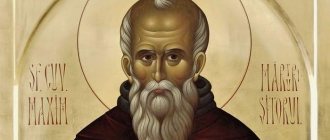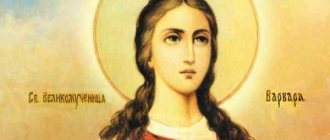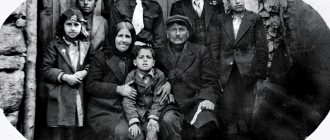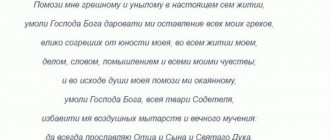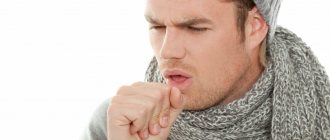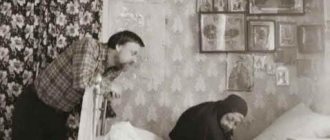August 31 – memory of the holy martyrs Florus and Laurus.
The holy martyrs Florus and Laurus lived in the 2nd century in Illyria (now the land of Yugoslavia). They were brothers not only in the flesh, but also in the spirit, since they unanimously believed in Christ and pleased God with good deeds.
The brothers were the most skilled stonemasons in Illyria. The ruler of Illyria sent them to the neighboring region to build a pagan temple as the best experts in construction. The brothers, working in construction, distributed their wages for their work to poor people and taught everyone the holy faith in Christ. They fed the hungry and poor, and at night they prayed for the enlightenment of people with the light of Christ's faith. The holy brothers converted many people to Christ, among whom was the priest of the pagan temple Memertin himself and his son.
One day, when Florus and Laurus were cutting a stone, the priest’s son stood nearby. It so happened that a fragment of the stone flew off and injured the young man’s eye. The angry father came running to the young man’s cry. Flor and Laurus reassured him and promised that the young man would receive healing. They took the young man into their home and began to teach him the knowledge of the True God Jesus Christ.
Saints Florus and Laurus prayed with tears to God that He would heal the young man and enlighten not only his physical eye, but also his spiritual eyes. After fervent prayer, the brothers made the sign of the cross over the sore eye - and the eye immediately healed and saw as well as before. Having been healed, the young man believed in Christ, and his father also believed, who from a servant of idols turned into a servant of the Lord Jesus Christ.
Having completed the construction of the temple, Saints Florus and Laurus broke and smashed the idols, and in the temple they erected a cross and, having gathered about three hundred people who accepted the faith of Christ, performed a prayer, glorifying Christ.
Flor and Laurus - patrons of livestock
During the all-night singing, an indescribable light shone in the temple.
Having learned about what had happened, the head of the region ordered all Christians to be thrown into prison.
All those praying in the temple were sentenced to burning, and Florus and Laurus themselves were sent to the ruler of Illyria.
The cruel Lycaon ordered the holy martyrs Florus and Laurus to be thrown into a deep well and covered with earth for the living.
Many years later, the holy relics of the martyred brothers were found and transferred to Constantinople. The Lord glorified their honest relics with healings and miracles. In 1200, the relics were visited by the Novgorod pilgrim Anthony, who saw their great healing power. According to oral tradition preserved in the Novgorod land, with the discovery of the relics of the martyrs Florus and Laurus, the loss of livestock stopped. Then the veneration of the holy martyrs Florus and Laurus began as patrons of horses and livestock. In the Balkans, a legend has been preserved that the martyrs Florus and Laurus were taught by the Archangel Michael the art of driving horses.
Who are Saints Florus and Laurus
On the last day of August, the Orthodox Church celebrates the memory of two Saints - Florus and Laurus. The brothers, who lived in the second century in the province of the Roman Republic of Illyricum, were connected not only by physical kinship, but also by spiritual kinship. They lived according to the commandments bequeathed by Jesus Christ, and therefore denied paganism.
One day, the brothers, as famous and skilled masons, stonemasons and architects, were sent to a neighboring province to build a pagan temple there. During construction, they fervently prayed to the Lord, and spent the money they received for their work on feeding the poor and disadvantaged. They themselves led an ascetic lifestyle and were content with little.
After some time, people rallied around Florus and Laurus, who received from the brothers not only food, but also instructions in the true faith in the One God. Even the local pagan priest and his son went over to the side of Christianity. They believed in Christ after the brothers, in the name of God, healed the young man’s wounded eye.
At the end of construction, the architects, instead of pagan deities, installed a cross in the temple. All the believers gathered and began to pray. They prayed all night and were rewarded with the Divine light that descended on the church. And in the morning everyone went together to the pagan statues and smashed them.
The local ruler, having learned about what had happened, ordered the arrest of Florus and Laurus, as well as their followers. More than 300 people, after much torture and torture, were killed and burned. And the brothers were sent to Illyricum, where they were buried alive underground in a deep well.
So Florus and Laurus accepted martyrdom for the Christian religion and left earthly life. Saints are glorified in both the Orthodox and Catholic churches. Their incorrupt relics were subsequently found and transported to Constantinople. There is a legend that after the relics were raised, the death of domestic animals in that area stopped. And they began to call God’s saints horsemen. On icons, martyrs are often depicted with horses.
Miracle of the Holy Martyrs Flora and Laurus
Miracle of Flora and Laurel
The iconographic plot of “The Miracle of Flora and Laurel” arose in Rus' in the 14th century and is unknown among other Orthodox peoples. This image speaks about the spiritual world, about the House of God no less than many volumes of writings.
The icon painters of Ancient Rus' theologized in colors, revealing the secrets of the spiritual world through visible images. The image of the holy martyrs Florus and Laurus is one of such revelations of ancient icon painters. Prince E. Trubetskoy writes about the plot of “The Miracle of Flora and Laurel”: “When we see these saints among a multi-colored herd of horses, playing and galloping, it may seem that in this cheerful picture we have an intermediate step between the iconographic and fairy-tale style. And this is especially because it was Florus and Laurus, more than any other saints, who preserved the Russian folk, even downright peasant, appearance; but they, having dominion over the horses, themselves, in turn, have their own guiding Angel, depicted on the icon... There remains no doubt that they are not independent bearers of heavenly power, but only merciful intercessors about the needs of the farmer who has lost or was afraid to lose your main wealth is a horse.”
The legend that served as the basis for the iconographic plot tells how the holy brothers came to the aid of a shepherd who had lost his horses and helped find the loss.
The earliest surviving icons with this subject date back to the 14th century, when icon painters did not allow any liberties in the images. Everything in them was determined by the iconographic original and the canon, firmly established and consecrated by the Church. So before us is an image consecrated by the ancient icon-painting tradition. Let's take a closer look at it.
In a single golden space (the background on icons with this subject is always golden or ocher-gold) the Archangel Michael is depicted in full size, facing the worshippers; and on the sides, half-turned towards him, are the holy martyrs Florus and Laurus. Below are two horses: black and white under elegant saddles. Archangel Michael hands the martyrs the reins of these horses. Below them are depicted shepherds galloping on horses - the holy martyrs Speusippus, Eleusippus and Meleusippus, driving a herd of horses of various colors to a watering hole. Usually these are ten horses (or thirteen, including the riders' horses).
This is an image of the Divine Economy, revealing the unity of the world created by the love of the Father. In the center of the image is Archangel Michael, standing on the top of the mountain. He occupies this place as the Archangel (i.e., leader) of the heavenly army, placed by God at the head of the Angelic hierarchy. His name translated from Hebrew means “who is like God.” Archangel Michael, fulfilling the command of God, cast down the fallen star and his angels from Heaven. He taught people after the Fall and their expulsion from paradise everything that they had to do while working to earn their daily bread - agriculture, cattle breeding, crafts. He was also the teacher of Moses, to whom he handed over the tablets of the law on Mount Sinai. Archangel Michael was the patron saint of God's chosen people. During the exodus of the Jews from Egypt, he was their leader; through him the power of God appeared, destroying the Egyptians and Pharaoh who were persecuting the Israelites. Archangel Michael protected the people of Israel in all disasters. His strength appeared in the capture of Jericho, in the destruction of one hundred eighty-five thousand soldiers of the Assyrian king, in the defeat of Iliodor, the military commander of King Antiochus, the persecutor of the people of Israel. Since ancient times, Archangel Michael has been glorified for his miracles in Rus'. As already mentioned, a legend came to Rus' from the Balkans that Archangel Michael taught the brothers Flor and Laurus to control horses.
The drivers of a herd of multi-colored horses depicted on the icon are the holy martyrs, twin brothers Speusippus, Meleusippus and Eleusippus, who lived in the 2nd century in Cappadocia (their commemoration is celebrated on January 16 (29). Their names are translated as follows: Speusippus means “accelerating the horse,” Eleusippus means “chasing a horse,” Meleusippus means “caring for a horse.” The brothers were grooms at the temple of the pagan goddess of fate, Nemesis. They were converted to Christ by their grandmother, Saint Leonilla and the holy presbyter Wenign. The brothers accepted holy Baptism and destroyed the idols. The pagans flared up with fierce anger towards them, leaders gathered from everywhere and began to interrogate the holy brothers.
Speusippus, Eleusippus and Meleusippus confessed Christ before the judges and refused to sacrifice to the pagan gods. They were tied hand and foot, hung on a tree and stretched so tightly that their bones began to come out of their joints, then they were thrown bound into the fire, but they remained unharmed, like the three youths in the Babylonian furnace, and glorified God. When the fire went out, the brothers said to the tormentors: “We have been given the power to pass over to Christ our God only when we ourselves want; but we decided to laugh at your madness in this life, although, nevertheless, we will not hesitate to appear at the heavenly feast.”
Finally, the three brothers bowed their knees and, having prayed, gave up their holy souls to God. Their bodies were buried not far from the city, where a temple was subsequently erected in their honor, in which many miracles and healings were performed.
In the icon, this group of three holy martyrs-horsemen, as if receiving grace from the Heavenly World, for service on earth. Galloping horses are a symbol of a world subject to change, living according to the laws of time. But there is no division here either. There is one world of God. The whips that the riders wave touch their ends to the robes of the Archangel Michael, for the power that helps to command the horses is drawn from the Heavenly World. Moreover, in an earlier image from the 14th century (now kept in the State Tretyakov Gallery), three martyred brothers are depicted in a single impulse driving horses: each repeats and, as it were, enhances the movement of the other. In a later image from Smolensk (17th century), this unity is no longer so obvious: horses and riders are distributed throughout the space of the icon. Here, the strengthening of the hierarchy is noticeable: the figure of Archangel Michael rises somewhat above Florus and Laurus, spreading protective wings over them, while on the 14th century icon Florus and Laurus, praying before Archangel Michael, do not differ in height from the Archangel (a detail essential for iconographic language). The hands of the holy brothers, as if a continuation of the hands of the Archangel, the lines of their hands form a cup, symbolizing the acceptance of Divine grace. The Archangel's wings embrace the world, forming another cup - a symbol of the outpouring of grace from the High Heights to the earth. Horses are a symbol of day and night, marking the passage of time. Their outline becomes on the icon a continuation of the Archangel’s wings - thereby the entire earth, both space and time, enters into communication with the Heavenly World.
From the earth there is a counter movement upward - the peaks of those mountains whose bases are on earth are in the Mountain World. The figures of the Archangel and the martyrs are painted in such a way that one gets the impression of intangibility, a complete absence of earthly gravity. They do not stand on the tops of mountains, but hover above them. Reverse perspective brings the figures closer together. Three - the holy Archangel, the leader of the heavenly army, and two martyrs, symbolize the unity of the Angelic world and holy people. In the icon they seem to be having a silent conversation.
The colors of the robes are red and green, and the golden (ochre-golden) background of the icon emphasizes the unity and harmony of the world in which the truth of God is created, and each of its essences is included in communion with God. Red is the color of Divine love, the color of the blood shed by the Son of God for the salvation of the world, the color of martyrs who suffered for the sake of Christ and the fulfillment of the righteousness of God. Green is the color of life of the plant kingdom on earth and the color of hope for the salvation of the fallen world. It is not for nothing that next to the saints we see images of green trees stretching upward. The shining gold background signifies Divine power, the victory of the Kingdom of Glory.
Prince E. Trubetskoy writes about it this way: “Icon-painting mysticism is, first of all, solar mysticism in the highest, spiritual meaning of the word. No matter how beautiful other heavenly colors may be, the gold of the midday sun is still a color from flowers, a miracle from miracles. All other colors are in some subordination in relation to it and, as it were, form a “rank” around it. Before him the blue of the night disappears, the twinkling of stars and the glow of a night fire fades. The very purple of dawn is only a harbinger of sunrise. And, finally, the colors of the rainbow, for every color and light in the sky and in the heavenly places is the source of the sun. This is the hierarchy of colors around the “Unsetting Sun” in our icon painting. There is no color of the rainbow that would not find a place in the depiction of otherworldly Divine glory. But of all the colors, only the golden one, the sunny one, means the center of Divine life, and all the others are its surroundings. God alone, shining “more than the sun,” is the source of royal light.”
White and black horses are depicted on the icon in dynamics and, at the same time, at rest. It’s amazing how the ancient icon painters were able to convey movement and peace at the same time! This dynamics tells of the aspiration of everything earthly and temporary towards the heavenly, where everything that begins finds completion in the peace of eternity. The movement of horses is an introduction to eternity, as well as a symbol of human labor in the universe as long as the “running of time” continues.
There is another icon, “The Miracle of Flora and Laurel,” where there is not this single space, but there is a division into three tiers. In the upper one, the Archangel Michael rises on the mountain, just below are Florus and Laurus, in front of them are white and black horses. On the middle tier, the brothers Speusippus, Eleusippus and Meleusippus are racing a herd of multi-colored horses. In the lower tier, images of Saints Spyridon and Blasius appear - new faces for this plot, but familiar to the popular consciousness, as patrons and intercessors for livestock.
Let us dwell on the lives of these warm prayer books about man and every creature.
Saint Spyridon (his memory is celebrated on December 12/25) was born in Cyprus, was a sheep shepherd from childhood, in memory of this, the saint is often depicted on icons wearing a shepherd’s hat woven from willow twigs. Subsequently, he was installed as bishop of the city of Trimifunt. The entire life of the saint amazes with the amazing simplicity and power of miracles given to him by the Lord. At his word the dead were awakened, the sick were healed, and demons were cast out. The saint's special gift was power over the elements. Through his prayer, the sky opened and life-giving rain poured down on the parched fields, the storm clouds dissipated, and the river flow stopped in its flow when the saint needed to cross it. In church hymns he is often likened to the prophet Elijah: “We see Spyridon, the great wonderworker, equal to the angel. Once upon a time, the country suffered greatly from lack of rain and drought: there was a famine and an ulcer and many people died, but through the prayers of the saint rain came down from heaven to earth, and the people, having been delivered from the disaster, gratefully cried out: Rejoice, thou art like the great prophet; Rejoice, for you brought down the rain that took away hunger and illness in good time” (Akathist to St. Spyridon).
In 325, Saint Spyridon was a participant in the First Ecumenical Council, at which, denouncing the heresy of the wicked Arius, he showed a miracle as proof of the Unity of the Holy Trinity: he took a brick in his hands and squeezed it - instantly fire came out of the brick upwards, water flowed down, but the clay remained in hand. “Behold, there are three elements, and the plinth (brick) is one,” the saint then said, so in the Most Holy Trinity there are Three Persons, but the Divinity is One.”
Fresco sschmch. Blasius, Monastery of St. Dionysius St. Mount Athos
Another saint depicted on the icon is the Hieromartyr Blasius, bishop of the city of Sebastia (his memory is celebrated on February 11/24). Before taking the episcopal rank he was a doctor. The Greek Menaion says that he was a shepherd as a child. The saint lived during the reign of the Roman emperors Diocletian and Licinius (III–IV centuries) – cruel persecutors of Christians. Many believers hid from persecution in deserted and secluded places. Bishop Blasius also retired to Mount Argeos and settled in a cave. Wild animals came to him and meekly waited for the saint to finish his prayer and bless them; The saint healed sick animals by laying his hands on them.
The mercy of Saint Blaise extended to every creature, which he loved with a truly godlike love for everything that the Lord created with His power and love.
The shelter of St. Blaise was found by the servants of the ruler of the region, who arrived to catch animals, which were then given to Christian martyrs to be torn to pieces. Saint Blaise was taken to the governor. Along the way, he healed the sick - people and animals, and performed other miracles. So, through his prayer, the wolf, who stole a piglet from a poor widow, returned the prey unharmed. When a lame dog met the saint on his way, the saint stopped, covered it with the holy cross, and she was healed.
For confessing faith in Christ, the governor of the region ordered Saint Blaise to be thrown into the lake. However, the holy martyr approached the water, made the sign of the cross over it, and walked as if on dry land. Turning to the pagans standing on the shore, the saint invited them to walk on the water, calling on their gods for help. Everyone who dared to do this drowned. The saint, obeying the command of the Angel, returned to the shore, after which he was beheaded. This happened around 316.
It is known that not only in Rus', but also in Greece, the Balkans, Dalmatia, that is, in many regions of the Byzantine world, Saints Spyridon and Blasius were revered as healers and patrons of animals.
Farmers and cattle breeders looked to heavenly patrons for support and help in everyday work and worries.
The icon “The Miracle of Flora and Laurel” reflects the unity of the world, the reality of communication with the Mountain World. The image reveals to the spiritual gaze Divine love for people, for all living things, reveals the secrets of God, brings consolation in sorrows and strengthening in labors. We see here the threshold of the kingdom of God, which has come in power and glory, the illumination of everything with the Divine light. Here we see a prototype of the eschatological vision of the New Jerusalem, where “the armies of heaven followed Him on white horses, clothed in fine linen, white and clean” (Rev. 19:14).
What do the holy brothers pray for?
Florus and Laurus bless those who remember them in prayer.
- The saints are glorified in prayers and hymns for their patience, love for people, and unshakable faith in the One God.
- Flora and Lavra ask for strengthening of faith, fortitude for the humble acceptance of all life's adversities.
- People turn to God's saints to heal people from alcoholism and direct them to the right path.
- Saints are considered the patrons of veterinarians. They help doctors treat animals.
- They appeal to the holy martyrs in order to soften the hearts of people and instill in them love and kindness towards our lesser brothers.
- Heavenly helpers help horses in their lives and hard work.
- They pray to them for protection from animal theft and help in finding lost ones.
- They are asked to heal pets.
Icon Florus and Laurus
The icon of the holy great martyrs Florus and Laurus personifies the intercession of the hearth, family happiness and material well-being. The holy face contains a wonderful iconographic story that fully reveals the whole picture of their righteous life.
Among the people, the sinless saints of God, Flora and Laurus, were considered the heavenly intercessors of all people whose work was in one way or another connected with breeding horses. Previously, a Christian image was present in every home, but with the cessation of active farming, the memory of Flora and Lavra began to gradually weaken. However, the holy martyrs established themselves not only as intercessors of horsemen, grooms and peasants; their righteous life went down in the history of the formation of the Christian religion.
History of the Florus and Laurel Icons
The Hieromartyrs Florus and Laurus lived in Byzantium and were each other’s blood brothers. They had a similar worldview, they both believed in the Lord and observed all church principles. By profession they were stonemasons, and they learned their craft from Orthodox believers Prokol and Maxim, who instilled in them the love of God and faith in Christ.
Saints Florus and Laurus worked on the construction of a temple for the pagans, gave their money to the poor, and themselves indulged in prayer and fasting. One day, a small pebble fell from the roof and injured the cornea of the eye of the son of Mamertine, one of the local pagan priests. The father was very angry, but the brothers, now saints, promised him that they would help heal the boy. They completely took the wounded boy into their care, introducing him to faith in Christ. Healing came as soon as the young man believed in the true God. His father, Mamertin, did not remain indifferent and himself accepted the Lord, abandoning idolatry.
When the church was built, Florus and Laurus gathered all the Orthodox, destroyed all the idols, erecting a cross, as a symbol of Christianity, near the church. Such self-permissiveness plunged the local ruler into rage, and his thoughts became blackened. At that very moment he gave the order to throw Mamertine, with his newly converted son and several hundred Orthodox believers, into the fire. And a terrible thing was in store for Florus and Laurus. While the ascetics of the faith were put on fire, the brothers were buried alive, thrown into a huge pit. Without flinching, the saints accepted death as a gift, giving their lives for the Son of God Jesus Christ.
Many years later, the relics of the Holy Brothers were excavated and moved to the capital of Byzantium. After the discovery of the incorruptible relics, attacks on livestock stopped, so Flor and Laurus are the protectors of livestock, especially horses.
Where is the face of the saints now?
The iconographic plot that reveals itself to us on the holy image of Florus and Laurus can be found in many churches in Russia and abroad. Before her they pray for the protection of household life, the preservation of livestock and material wealth. Many Christians venerate this icon and keep it at home as a talisman.
Memorial Day Icons
Previously, on August 31 (August 18, old style), people celebrated a revered holiday, which received ardent love and fame among the people. At this time, people celebrated the day of remembrance of Florus and Laurus, who were glorified as protectors of horses and cattle. At this time, all horses were freed from work, they were bathed in lakes, and then satin ribbons were braided into their manes.
What does the Icon of Florus and Laurel help with now?
The icon of the great martyrs Florus and Laurus protects the house from enemies, quarrels and misfortunes. The saints also help in finding a well-paid job and gaining material wealth. They preserve not only family well-being, but also protect livestock. Before the icon, Orthodox people pray for different things. Martyrs are called to preserve personal happiness, protecting them from evil and crafty people.
Description of the Icon
The icons traditionally depict the brothers Florus and Laurus, usually surrounded by cattle. Also on the icons, next to the martyrs, icon painters depict angels. Most of the icons are painted in the spirit of Russian traditional fairy tales to emphasize the folk spirit of the brothers. On some icons we can see Florus and Laurus riding on horses, since it is for horses that the brothers are the patrons to a greater extent.
Prayer before the holy image
“The great martyrs Florus and Laurus were hidden underground, but ascended to the heavens of God. Let us honor your memory in prayers. Hear us and don't ignore us. In our prayers we ask you to protect our homes from enemies and all kinds of wickedness; deliver us from our need for food, water and all material benefits. May there be peace in our country and on the whole earth. Protect our livestock from disease and death. Get rid of anger, lies and suffering. We pray only to you, O Holy Brothers Florus and Laurus! May you be sung and glorified by us forever and ever! Amen!"
The Orthodox faith is being revived since the times of persecution and extermination of the Christian people. It is when the culture of religion gains its relevance, significance and respect in the life of every believer that icons gain power. Let the holy face of the brothers Flor and Laurus become the personal intercessor of your family well-being. Buy this icon for yourself and pray for the help of the holy martyrs until happiness returns to your home. We wish you strong faith. be happy
Reading rules
Prayers are a gift people receive from God. Through them, people have the opportunity to convey their requests to the saints, feel involved with the Higher powers, and receive real help.
- It is advisable to contact the saints in church. The setting of the temple, many icons, and prayer chants give peace and a feeling of peace. If this is not possible, then you can pray at home in front of the icon of Florus and Laurus with a lit church candle.
- When reading a prayer, there should not be a shadow of doubt that help may not come. Doubts kill faith. And without faith there is no salvation.
- It is better to pray out loud, but mental prayer is no less powerful. The main thing is to pronounce it as sincerely as possible, fill it with feelings and understanding.
- You need to pronounce the words of the prayer clearly, remembering that each of them contains grains of truth and power.
- You cannot pray hastily. Only by pacifying the bustle and calming your thoughts can you pass prayer through your heart and feel the joy of communicating with Heavenly helpers.
Prayers addressed to saints are precious for believers, as they fill life with Divine light, instill hope and peace.

